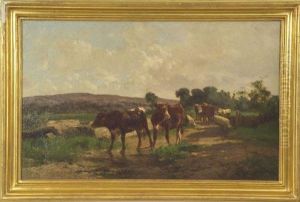Charles Quinsac Paintings
Charles Quinsac was a French painter born in 1851 in Bordeaux, France. His artistic journey began under the tutelage of local painter François-André Vincent. Quinsac later moved to Paris to further his studies and became a student at the École des Beaux-Arts. He studied under the prominent academic painters Alexandre Cabanel and William-Adolphe Bouguereau, both of whom were highly regarded for their mastery of technique and form, as well as their influence on the academic art circles of the time.
Quinsac's work can be described as embodying the academic tradition, which emphasized classical themes, historical and mythological subjects, as well as a highly polished technique. He was a traditionalist, and his style did not deviate significantly from the established norms of the period, reflecting the influence of his mentors. His adherence to the academic style meant that he was somewhat at odds with the emerging contemporary movements of the late 19th and early 20th centuries, such as Impressionism, which sought to break away from the strictures of academic painting.
Throughout his career, Quinsac participated in the Salon, the official art exhibition of the Académie des Beaux-Arts in Paris. His work received recognition and he was awarded medals for his contributions to French art. Despite his successes, Quinsac did not achieve the same level of fame as some of his contemporaries. His work was appreciated for its beauty and craftsmanship, but it did not push the boundaries of art in the way that other movements of the time did.
Charles Quinsac passed away in 1924. While his name may not be as widely known as some of his contemporaries, his paintings remain a testament to the skills and traditions of the academic art world of the 19th century. His works are held in private collections and can be found in regional museums in France, serving as examples of the refined artistic techniques of his time.
